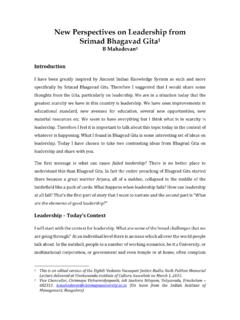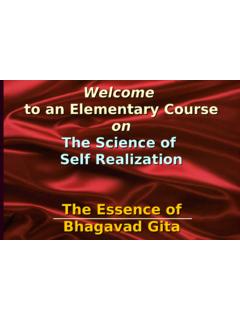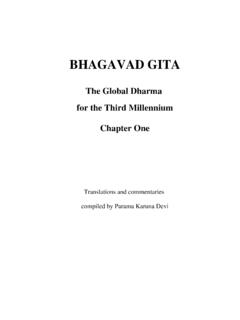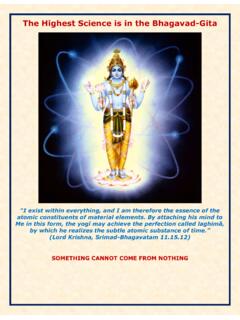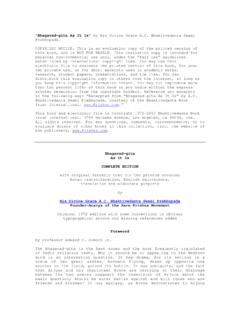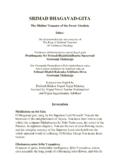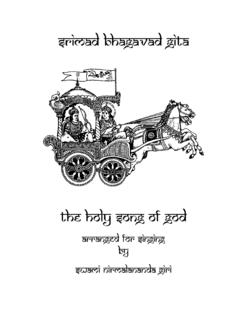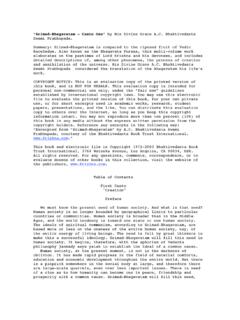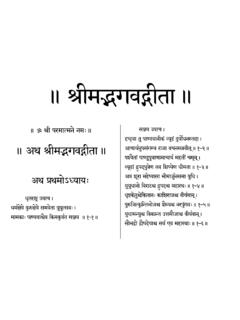Transcription of The Bhagavad Gita: The Roadmap to Conscious Evolution ...
1 I Journal of Conscious Evolution Issue 10, 2013 The Bhagavad Gita: The Roadmap to Conscious Evolution . Understanding the Eternal Reality of Consciousness Sadna Chopra1 The Graduate Institute, CT ABSTRACT The purpose of my study is to present the knowledge of the Self (our true nature) and the knowledge of what Consciousness is, from the sacred text of the Bhagavad Gita. I have examined how the verses of the Gita unfold into a Roadmap for the Conscious Evolution of the self. Objectives: To present the layers of meaning of the sacred text of Bhagavad Gita, literal and allegorical, as explained by the illumined seer, Parmahansa Yogananda, the great spiritual teacher, Swami Chinmayananda, renowned scholar and philosopher, Dr. Sir. S. Radhakrishnan and, educator and author, Eknath Easwaran.
2 To understand the journey that the self undertakes to seek its true nature and to understand how the Gita illumines the ultimate mysteries of the Divine Consciousness, the Brahman; To establish that the Bhagavad Gita is a primer in its truest essence, a practical manual to Conscious Evolution . Introduction: People travel to wonder at the height of mountains, at the huge waves of the sea, at the long courses of rivers, at the vast compass of the ocean, at the circular motion of the stars; and they pass by themselves without wondering. St. Augustine How does one begin this wondrous journey into one s inner self? As I pondered, I realized that the path is usually in front of us, we just need to look at it with a fresh pair of eyes. It is like walking in this beautiful valley covered with dense fog-as one treads on the path, a small segment of it, the one right in front of you becomes visible.
3 Though you can t see very far ahead, you just keep moving, with your intuition guiding you, with the faith that things will be clearer in time. There are many, who have treaded this path, and have discovered their True Selves. The fog does finally lift and reveals the vale, the vale of Beauty and Truth, Serenity and Supreme Peace, of Supreme Joy and Unparalleled Bliss. That sanctuary is right within each one of us. I am reminded of these beautiful lines by Eliot, We shall not cease from exploration, 1 ii And the end of all our exploring Will be to arrive where we stand And know the place for the first time Fortunately for us, the sages and seers of the ancient wisdom traditions have saved even the minutest observations of this evolutionary journey of self-awareness in the visionary documents, which were, for centuries, committed to memory and then written down to come to us as the earliest, purest forms of the Perennial Philosophy.
4 srimad Bhagavad Gita, the Divine Song of the Spirit is the quintessence of the Vedic and the Upanishadic Scriptures. It is the most comprehensive canon of the Perennial Philosophy. The Gita is metaphysics and ethics, Brahmavidya and Yogashastra, the science of reality and the art of union with reality. (Radhakrishnan, 1948, p. 12) The Gita, the finest mystical treatise is embedded in the vast epic, the Mahabharata, composed by the ancient seer Veda Vyasa. The Mahabharata presents a vast canvas, and its dramatic layout has brought out the philosophical exposition to its vibrant colors, in the Upanishadic form of conversation between the teacher and the student. The fratricidal struggle, the setting of this Great War forms the ground for the development of a spiritual message based on the ancient wisdom, prajna purani, of the Upanisads.
5 (Radhakrishnan, 1948, p. 13) Dr. Sir. S. Radhakrishnan, in his introductory essay to his translation of the Bhagavad Gita writes that, every Scripture has two qualities, one, temporary and perishable, that reflects the ideas of the people, the period and the country in which it is produced; and the second, eternal and imperishable. The permanent truths are capable of being lived and seen by a higher than intellectual vision at all times. (Radhakrishnan, 1948, p. 6) The Gita is a perennial philosophy; eternal and applicable to the past, present and the future. How is this study significant to me and to you? Who am I? What is the purpose of my life? How am I connected to this Universe? How does this individualized soul in each of us come to be? What is the nature of this Divine Ground of Consciousness that we all come from?
6 How does one live in the Highest Self while continuing to work in the world? Is there continuity beyond this life? How does the soul evolve? These and many more are the questions that I am seeking an answer to. As I started trying to understand the Gita, one word, one verse at a time, I felt that the answers to all my questions are right here, in front of me and they have always been. The answers continue to unfold depending on my readiness to receive them. This is just the very beginning of this beautiful journey and the Bhagavad Gita is the most essential primer or the handbook of life to guide me through this Truth that I believe is ultimately realized in the depth of one s inner self. The Gita shows how a human being can naturally and consciously evolve through right thoughts and actions while understanding his own natural inclinations and tendencies.
7 The sacred text teaches how each being can live in harmony with Nature s Divine Wisdom. As the most comprehensive guide on meditation, it shows a step by step method to reverse the flow of consciousness from matter to Spirit. It illumines the inner realm of soul and Spirit. iii As Rumi says: And you? When will you begin your long journey into yourself? Literature Review: There are many editions of the Bhagavad Gita and innumerable translations of the sacred text by renowned scholars, linguists, literary figures and spiritual teachers. Dr. Sir. S. Radhakrishnan writes that no translation of the Gita can bring out the dignity and grace of the original. Its melody and magic of phrase are difficult to capture in another medium. (1948, p. 7) The commentary on the Gita by the great thinker and Advaitic philosopher Sri Adi Shankaracharya ( 788-820) is the most ancient of the existing commentaries.
8 Samkara affirms that Reality or Brahman is one without a second. The entire world of manifestation and multiplicity is not real in itself and seems to be real only for those who live in ignorance (avidya). (Radhakrishnan, 1948, p. 13) For my humble endeavor in understanding the teachings of the Bhagavad Gita, I have very heavily drawn from the works of the following luminaries: God Talks with Arjuna. The Bhagavad Gita by Paramahansa Yogananda The Yoga of the Bhagavad Gita by Paramahansa Yogananda The Bhagawad Geeta by Swami Chinmayananda The BHAGAVADGITA by Dr. Sir. S. Radhakrishnan The Bhagavad Gita by Eknath Easwaran Also, the Song of the Lord sung by Bhajan singer, Anup Jalota and its Hindi translations narrated by Pandit Vishnu Sharma and the book, Bhagavad Gita by Swami Prabhavananda and Christopher Isherwood has been an invaluable resource.
9 Why did I choose these books for my study? Eknath Easwaran (1910-1999), educator, developer and teacher of passage meditation and the founder of Blue Mountain Center of Meditation, CA, discovered for himself the Divine Ground of Existence in the teachings of the Gita and wanted to share it with others. Easwaran brings out Gita s timeless wisdom in his beautifully translated verses which are simple to understand. He gives the historical context, the explanation of the fundamental concepts of the Upanishads and sets the stage for the unfolding of the Scriptural text for the understanding of the modern reader. Easwaran beautifully summarizes each chapter before presenting his translations for each of them. Dr. Sir Sarvepalli Radhakrishnan (1888-1975), an eminent and erudite scholar and statesman, was the first Vice-President of India (1952-1962) and the second President of India (1962-1967).
10 One of the most influential scholars of comparative religion and philosophy, he wrote authoritative exegeses of India s religious and philosophical literature for the English speaking world. His birthday, September 5th, is celebrated as Teachers Day in India. His translation of the Gita is very beautifully written. The introduction is very enriching and he explains the historical and social context of the Scripture. His literature review is very extensive. Each verse is beautifully and skillfully translated and is followed by a commentary with quotations from the Vedas and the Upanishads, the Bible, the sacred Puranas, from iv Shankaracharya s Brahma Sutra and from the works of the eleventh century philosopher, Ramanuja. Radhakrishnan s explanations are also supported by beautiful lines from Plato s Phaedo, quotes by Socrates, the works of Plotinus, Lucretius, Spinoza, St.
